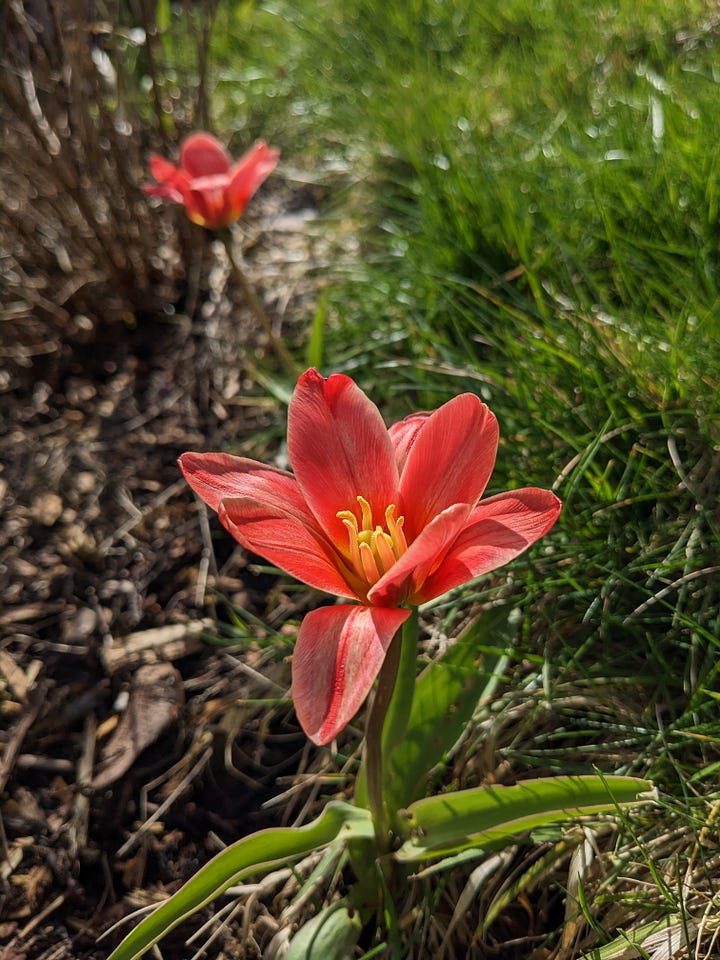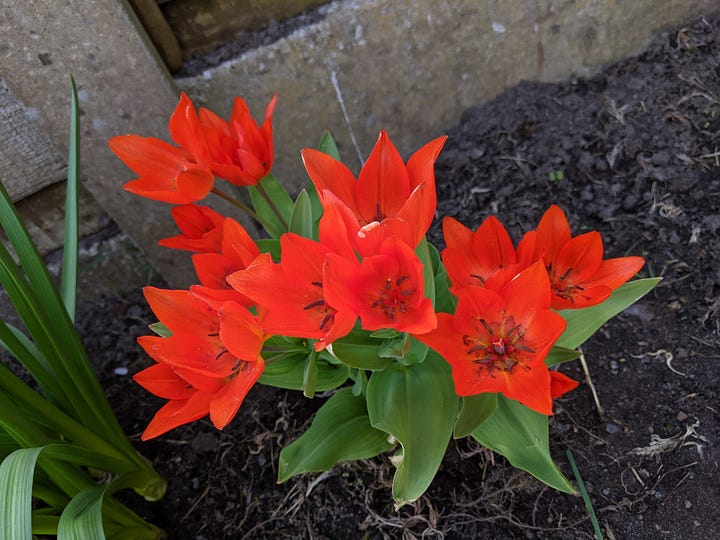If you’ve been following along, you’ll notice an obvious theme. The curious child within myself points at a plant and says “Can I eat that?”. That’s really all it is, plus research and some thought, which is just the grown up icing I hide behind.
I’m surprised, and maybe I should by now not be, by how often a random plant in my suburban surroundings is edible to some degree.
A fleeting comment I came across - and have since lost to the internet ether - mentioned the edibility of tulips and, sucker I was, I dove right in.
Your typical “Westerner” accepts quite a few flower petals in various guises. We all know of rose petals as a decorative garnish on cakes and other sweet things, and of course there’s Elderflower cordial. Pressing up against the cage of belief is the nasturtium that is commonly grown as a trap plant in your standard vegetable plot but also consumed as a peppery side garnish. And no, I don’t really count broccoli, cauliflower or figs and neither does your average Joe.
There are likely other floral-based foods, but my point is that flowers do not play a major part (unless by stealth) of anyone’s diet.
I wouldn’t be wasting your time discoursing about edible flower petals if tulip petals are not the same. One article from “The Guardian” newspaper waxes lyrical about them
The best tulips for eating fall into three groups. They are scented; fragrance contributes heavily to flavour, they have bite and texture, breaking and crunching noisily when eaten, and they are beautiful.
We could end on this beautiful note, but here is the twist which I was quite surprised by. My articles in this series generally proceed as follows: “plant X used to be eaten in times past, but is now used for decoration, let’s start eating and domesticating plant X again”.
In the case of tulip bulbs, this has been turned on its head. The story in this case is: “tulip bulbs used to be eaten infrequently hundreds of years ago, but were then mostly used for decoration until people started eating them again".
What could cause humans to eat a decorative plant? War: specifically, World War II.
Let’s read on.
The situation was bleak in 1944 as the Nazis were occupying the Netherlands and funnelling off food to Germany or just blockading the sea ports. The Dutch Government had already been adulterating everyday foods with tulip bulbs from as early as 1941. Regeerings-koffiesurrogaat, or literally government coffee surrogate contained “52% barley or rye, 20% chicory, 12% coffee, 8% green peas and 8% tulip bulbs”.
The Dutch call the famine at the end of 1944 through to early 1945 the hongerwinter, or the Hunger Winter. I won’t reproduce the recipes for tulip based cuisine here - you can look them up in the references and judicious online searching - but suffice to say, tulips were marketed by the Dutch Government as a starchy potato substitute.
For those who don’t know, the Dutch are famous for growing and selling tulips. Even after the collapse of Tulip mania in the 1630s, Holland has remained a major exporter. So what do you do as a nation when there’s nothing else to eat? You eat your ornamental exports (that no one is buying anyway, because there’s a war on).
I’ve seen mention of tulip bulb soup (stamppot), porridge, mashed tulips (à la potatoes), fried tulips, roasted tulips. Tulip bulb flour was used to make savoury and sweet tulip cookies and tulip bread. Judging by these real life recipes, tulips really were force marched into the potato role.
From my research, there are a few things to watch out for if you want to try cooking a tulip bulb.
Make sure to remove the yellow centre part which contains the flower bud as well as any hard parts. In all the Dutch recipes I’ve perused this is an important step as those centre parts are considered toxic.
Secondly, make sure you wear gloves when preparing your bulbs. There’s a form of contact dermatitis called “tulip fingers” which some horticultural workers develop after prolonged skin contact with the bulbs.
Finally, don’t just eat any old tulip bulb as the original growers might have used some kind of herbicide/pesticide/fungicide. Consider purchasing “organically” grown tulips, or perhaps growing them from seed if you’re lucky enough to find a fertile ornamental variety (not easy, as they’re so inbred and likely to be bearing disease that reduce fertility from over propagation).


It seems that the Dutch quite happily abandoned tulip consumption after the second world war and I don’t blame them. Who would want to be reminded of such a time of famine? But in a way, it is a shame because tulips hit all the right notes for a forest garden. They look pretty, need no maintenance, can be propagated repeatedly from the bulbs, have tasty petals and bulbs with high starch density. An average bulb has more calories than the average potato!
All to say, you could make a pretty nutritional meal from a patch of tulips!
Next time you have a spot spare in your forest garden, consider some tulips and remember the legacy of the Dutch in the 1940s who were forced into a crash course of tulip based cuisine.
Let’s not waste their sacrifice; recipes at the ready!
Final Thoughts
Outside of the Dutch and recipes, there is remarkably no research on whether tulip consumption is “safe”. Interviews with Dutch survivors generally talk about some form of gastrointestinal distress but I’m starting to think this was because the centre parts were not removed, or that the bulbs that were stored over-long.
You’ll occasionally come across their toxic affects on household pets, so proceed with caution.
I never did say what species of Tulip we’re talking about, and that’s because the starving Dutch were not discriminate either; whatever they used to sell before the war is what they ate, and this is really the modern day garden border tulip.
If we insist on being specific, most ornamental garden border tulips are Tulipa gesneriana, a species created from complex hybridisation (likely with lots of inbreeding) to achieve the perfect ornamental form and colour. I question whether they are really a new species as they seem to be generally sterile.
I found only a few examples of tulip consumption before the modern times: Tulipa montana (wild mountain tulip) was actively consumed in Iraqi Kurdistan in the last century, and apparently sold at the markets in Mosul in Northern Iraq. There are also very rare occurrences of eating Tulipa armena (Armenian tulip) raw too. Tulipa montana bulbs are said to be a sweet and crunch snack; fancy a nibble?
Moving back to the 1600s, I found two accounts of garden tulips being preserved in sugar and consumed like sweets (more properly known as “sweetmeats”, back then).
If anyone has tried a tulip bulb, please get in touch!
Until next time.
PS: Possibly in the new year, I might have a break over the festive season.
References
Eating Tulipa montana and T. armena as a snack
Contact dermatitis from prolonged tulip bulb handling, from the Tuliposide A sugar (also known as “Tulip Fingers”)
Contact dermatitis from handling tulip bulbs that had an excess amount of applied fungicide
Interviews and accounts of Tulip based cuisine in the Netherlands during WW2, a great example of ethnobotany being applied to very recent times.
“The Tulip” by Anna Pavord, 2000 edition:
On page 57, Carolus Clusius was recorded to have preserved tulip bulbs in sugar and eaten them as a sweetmeat in 1562
On page 101, John Parkinson was said to have done the same some time around 1635.
The excellent Christianne Muusers, who specialises in culinary history, has an entry on Tulip consumption in WW2, with a recipe for Tulip bulb soup
An excellent article on Atlas Obscura about the Hunger Winter in the Netherlands, including some delicious sounding Michelin-starred tulip cuisine. How things have changed.
A recipe for tulip bulb cookies, and another account of the Hunger Winter
A list of edible and poisonous flowers
Of course, you can ferment Tulip bulbs to make vodka - I’m not paid to advertise this.





Thanks for pointing me towards this post! How fascinating! Ps, you probably know this but just in case, the fresh seeds on nasturtiums are gorgeous pickled 😉
Gotta tell ya, was a bit worried when I got an email from you titled Tulips...
I know an anecdote story of a group of drunk and desperate students that in a dark late winter night making salad from tulip leaves (not petals) and then vomiting profusely :D but the story goes it was because of the slime the leaves make :D also could have been the vodka :D